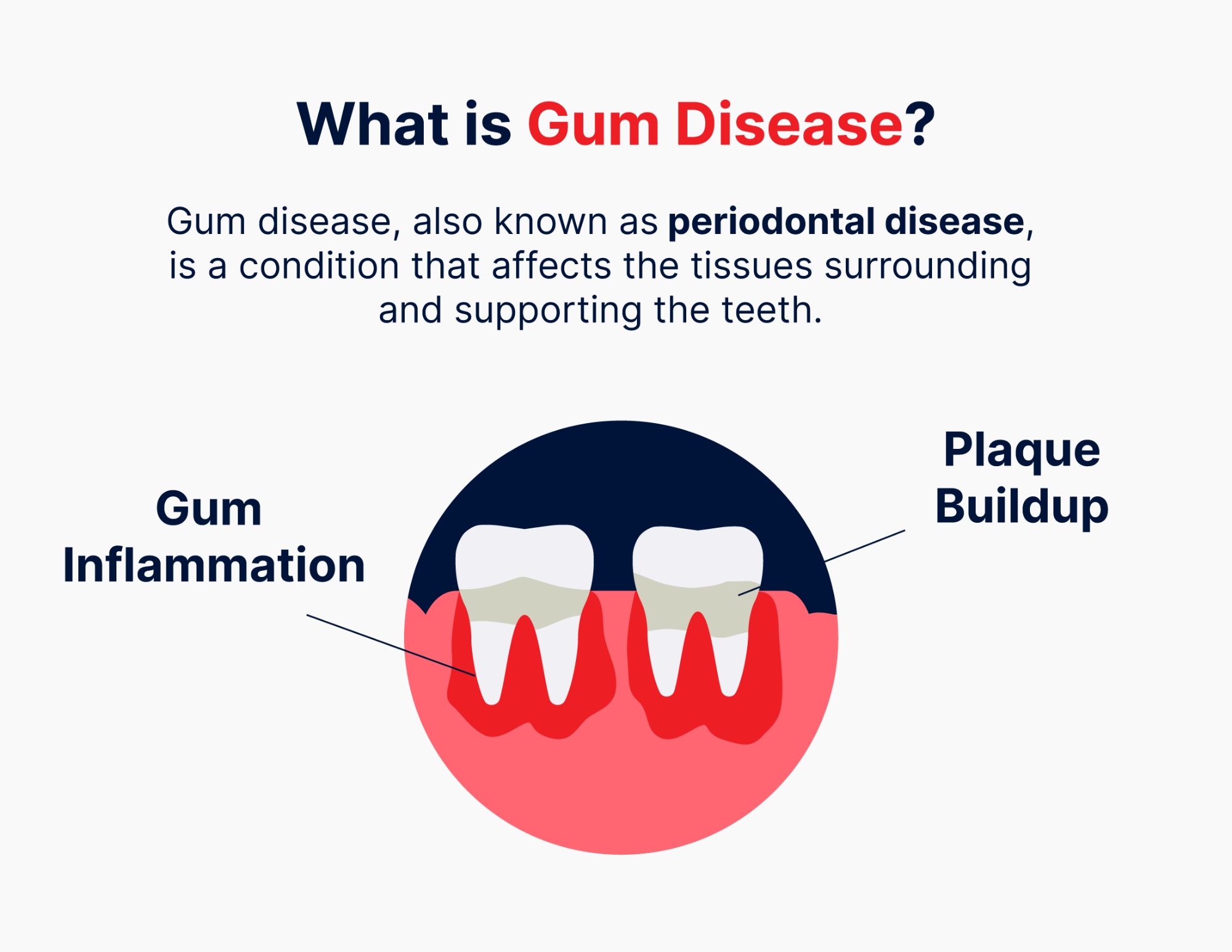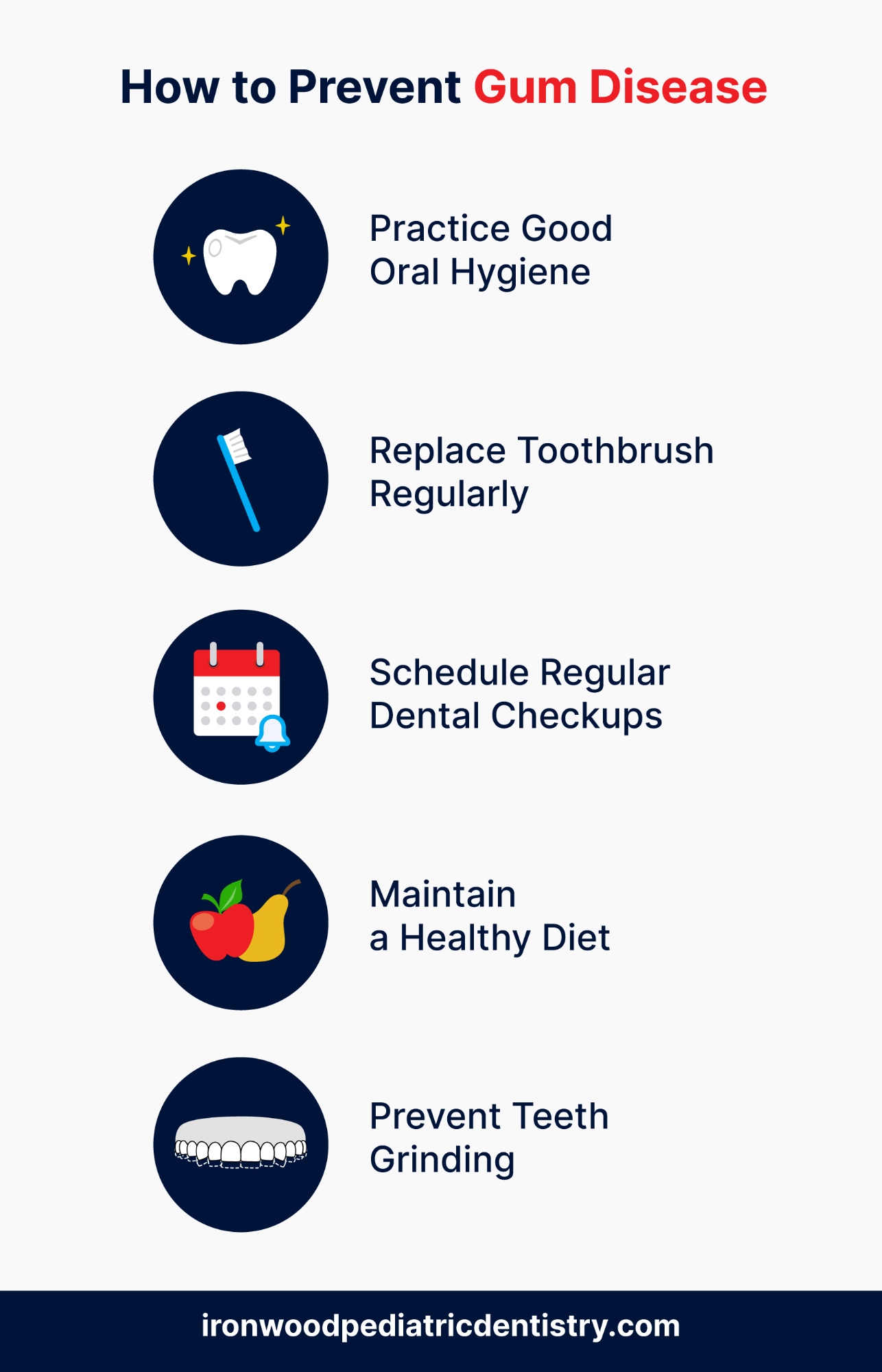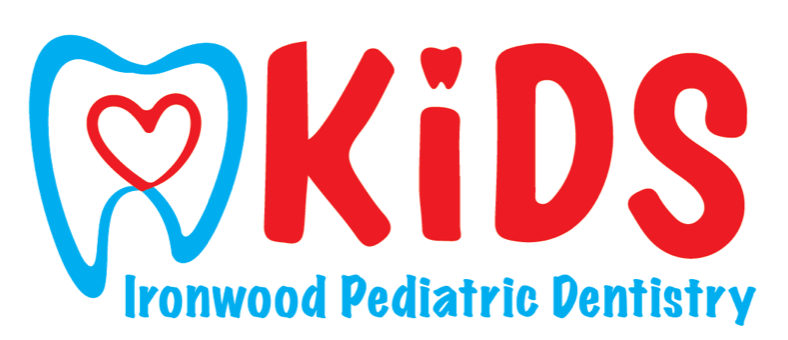Gum Disease Treatment Scottsdale, AZ
Home Pediatric Dentistry Gum Disease
Keeping your kids’ teeth clean can be challenging by itself, but do not forget about their gums. Gum disease can be a serious problem for your childrens’ dental health, too—one that affects their teeth as much as tooth decay can.
Find out here what gum disease is, how to prevent it from affecting your child, and where to find gum disease treatment near you if it does take hold.
What is Gum Disease?
Gum disease describes a bacterial infection of your gum tissue. The most common cause of gum disease is poor oral hygiene that allows plaque and tartar to build up at the gumline. Other factors can also increase the possibility that your child will experience this common dental health problem, and we will cover them as well.

Stages of Gum Disease
Gum disease develops in two stages. The early stage is called gingivitis. If gingivitis goes untreated, it can worsen into periodontitis, the next stage and a more serious gum condition that can threaten the teeth and jaw bone as well.
Gingivitis
Gingivitis is common in children. Gingivitis happens when bacteria that live in your child’s mouth are left alone long enough to build up plaque, a sticky film that is a mixture of food residue and bacterial waste. Plaque produces an acid that corrodes the enamel of your teeth. Hardened plaque becomes tartar that can eventually contribute to cavities.
But that is not the only harm it does.
If brushing and flossing do not remove plaque, it can begin to harden into tartar within three days. Tartar buildup, in turn, leads to gingivitis.
Early signs of gingivitis include:
- Redness and swelling in the gums.
- Bleeding gums—usually during tooth brushing and flossing—but it can also occur outside those activities.
As gingivitis worsens, you might notice these additional gum disease symptoms:
- Persistent bad breath or bad taste in the mouth that lingers even after brushing.
- Sensitive teeth that give you pain when consuming hot or cold foods or beverages.
- Pain when chewing.
Although poor oral hygiene is the most common cause of gingivitis, other risk factors can make your child more vulnerable to it. These include:
- Poor nutrition, especially a lack of vitamin C in the diet.
- Gender: boys are at more risk of developing gingivitis than girls, possibly because of hormonal reasons.
- Other conditions:children who suffer from Type I diabetes or Down syndrome are more likely to have gingivitis.
- Heredity:In some cases, your family’s genetic history can make it more likely that your child will develop gingivitis.
Periodontitis
Periodontitis is what happens when gingivitis is left untreated.
Periodintitis occurs when gum inflammation from gingivitis becomes bad enough that tartar (also known as calculus) builds up, creating periodontal pockets along and underneath the gum line. The further down these pockets go along the tooth root, the more they threaten it and ultimately the jaw bone itself with tissue destruction.
Once these pockets are established, tooth brushing is ineffective as a way to remove them, and flossing can become much less effective. Only your child’s dentist can fully remove tartar from teeth.
As a parent looking at your child’s teeth and gums, the onset of periodontitis can be hard to tell apart from gingivitis. This is because periodontitis is a progressive development from gingivitis, so the symptoms are mostly the same.
What will definitely not be apparent to you, however – your dentist has the training and experience to recognize it, but you do not – is the ongoing destruction of dental tissue, tooth and root enamel, and even the jaw bone that is all taking place underneath.
Another tricky thing about knowing whether your child has periodontitis is that it often does not always progress at a constant rate. It can seem to “lapse” at times, and during those intervals your child might even feel a lessening of symptoms. But periodontitis does not go away on its own, and eventually it will resume its destructive activity. Only your dentist can stop it.
As periodontitis takes hold and worsens, the gum tissue where the pockets have formed will begin to separate from the teeth. This is when periodontitis becomes easier for you and your child’s dentist to recognize by its new symptoms, that appear on top of the existing gingivitis symptoms, which will worsen.
Warning signs of periodontitis include:
- Receding gums. Also known as “long teeth” because of the exposure of the tooth’s root structure that used to be covered and protected by gum tissue.
- Worsening of bleeding gums. You might begin to see gum bleeding after tooth brushing as well as after flossing.
- Loose teeth. As the gums recede from the teeth and the pockets under the gum line grow larger, this can lead to teeth becoming loose and moving out of position, affecting the way teeth fit together when biting down.
Children can experience two kinds of aggressive periodontitis:
- Localized aggressive periodontitis can affect young healthy children. It is found in teenagers and young adults, and mainly affects the first molars and incisors. It is characterized by the severe loss of alveolar bone.
- Generalized aggressive periodontitis may begin around puberty, and involves the entire mouth. It is marked by inflammation of the gums and heavy accumulations of plaque and tartar. Eventually it can lead to bone loss, causing the teeth to become loose and, in some cases, to fall out.
Additional Possible Effects of Gum Disease
In addition to its direct effects on your child’s oral health, advanced periodontitis can possibly contribute to other physical problems. These include diabetes, a family medical history of gum disease, and some respiratory and heart conditions.
How to Prevent Gum Disease
The most effective way to keep from having gum disease is to deny it a foothold in your child’s mouth. This means making sure that your child follows good oral care habits. Here are some specific activities you and your child can take.

Practice Good Oral Hygiene Behaviors
The saying, “An ounce of prevention is worth a pound of cure” applies well to keeping gum disease from getting started. Encourage your child to do the following until they become habits:
- Brush at least twice daily, for at least two minutes per session.
- Use a fluoride toothpaste.
- Flossing regularly after brushing.
- Use an antibacterial mouthwash after brushing and flossing.
- Replace your child’s toothbrush at least every three months.
- Schedule regular dental checkups, including dental cleanings with your pediatric dentist twice a year.
Other Ways to Reduce the Risk of Gum Disease
There are other, lifestyle-related activities you can either do for your child or encourage your child to do that can lower the chance of gingivitis taking hold.
- Eat a healthy diet. Poor nutrition can weaken your child’s immune system, which can help gum-disease-related problems to develop. In particular, foods high in vitamin C and antioxidant content, like green leafy vegetables and citrus fruits, can help your gums to stay healthy and repair themselves against minor damage from gingivitis.
- Avoid eating foods high in sugar and starch. Foods that have a lot of sugar or starch in them, like candies, sweets, and soft drinks, are the equivalent of high-octane fuel for the bacteria that create plaque.
- Do not grind or clench the teeth. Especially if gingivitis or periodontitis sets in, the pressures that tooth grinding and jaw clenching put on already weakened gums can worsen the rate of tissue destruction.
Treatment for Gum Disease
It is important to know that even in its more advanced stage, your child’s dentist can still treat gingivitis before any permanent damage to the gums and teeth occurs. Often all this requires is regular check-ups and teeth cleanings, backed up by regular brushing and flossing in between dental visits.
If during a check-up or dental cleaning your child’s dentist believes that gingivitis or periodontitis is present, then X-rays may be needed to confirm that diagnosis and to better reveal the extent of the gum disease progression.
If gum disease exists, then the goal of treatment will depend on how serious it has become when treatment begins. If regular cleanings and good oral hygiene habits are not enough to reverse early gingivitis symptoms like bad breath, then more involved procedures may be necessary to stop the infection from getting worse and to repair any damage already done. Treatment options range from deep cleanings and medications to combat bacterial growth to more involved procedures like root planing and restorative oral surgery to shore up loose teeth.
In most cases, we can treat gum disease problems in the same Scottsdale office, where we provide our regular child dentistry services. In some cases of advanced gum disease, though, a periodontist – a dentist who specializes in periodontal disease treatment – may need to become involved in your child’s treatment plan. At this level of treatment, more aggressive ways of fighting gum disease and fixing its damage, like tissue grafting, scaling and root planing, or dental implants, may be needed.
Your dentist will be able to advise you on the specific treatments your child will need, based on his or her unique circumstances.
Act Now to Stop Gum Disease in Your Child
If you believe that your child is showing signs of gum disease, then the time to act is now. If we can catch gingivitis early enough, we can reverse it. If we can arrest periodontitis early enough, we can keep it from spreading further and leading to more serious dental problems like tooth loss.
There are no practical, self-help, over-the-counter remedies for advanced gum disease like periodontitis. Only your dentist can effectively remove tartar from teeth by a professional cleaning underneath your child’s gum line.
There is no advantage in waiting for dental care for gingivitis or periodontal disease. Left untreated, gum disease only gets worse the longer you leave it alone.
Treating Gum Disease in Scottsdale, Arizona
Call us at Ironwood Dental today at 480-422-4544 to schedule a dental care appointment at our Scottsdale pediatric dental office. Or, if you prefer to communicate with us online, you can ask a question or set up an appointment here.


